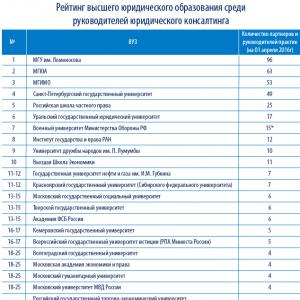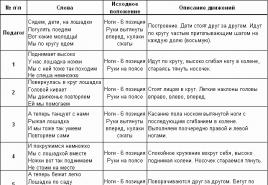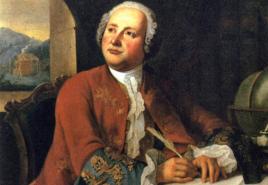Enthalpy - what is it in simple words. To thermodynamics
Internal energy, the energy of a body, depending only on its internal state. The concept of internal energy combines all types of body energy, with the exception of the energy of its movement as a whole and the potential energy that the body can possess if it is in the field of some forces (for example, in the field of gravitational forces).
Enthalpy (H) is a property of matter that indicates the amount of energy that can be converted into heat.
Enthalpy is a thermodynamic property of a substance that indicates the level of energy stored in its molecular structure.
This means that while matter can have energy based on temperature and pressure, not all of it can be converted to heat. Part of the internal energy always remains in the substance and supports it molecular structure. Part kinetic energy substance is not available when its temperature approaches the ambient temperature. Therefore, enthalpy is the amount of energy that is available for conversion into heat at a certain temperature and pressure. Enthalpy Units - Imperial thermal unit or joule for energy and J/kg for specific energy.
The enthalpy or energy of the expanded system E is equal to the sum of the internal energy of the gas U and the potential energy of the piston with the load Epot = pSx = pV
Thus, the enthalpy in a given state is the sum of the internal energy of the body and the work that must be expended in order to introduce a body of volume V into environment, which has a pressure p and is in equilibrium with the body. The enthalpy of the system H - similarly to the internal energy - has a well-defined value for each state: ΔH = H2 − H1
If the system somehow returns to its original state (circular process), then the change in any of its parameters is equal to zero, and hence ΔU = 0 and ΔH = 0.
Entropy is a concept that first appeared in thermodynamics as a measure of the irreversible dissipation of energy.
Entropy (S (J/K)) is related to the number (W) of equiprobable microscopic states that can realize a given macroscopic state of the system by the equation
Where K is the coefficient of proportionality.
Ideally correctly constructed crystals at absolute zero have the lowest entropy. The entropy of a crystal that has any irregularities is somewhat larger.
With increasing temperature, entropy always increases, and it also increases during the transformation of a substance from a crystalline state into a liquid state, and especially during the transition from a liquid state to a gaseous state.
Entropy depends only on the state of the system. But the connection between the change in entropy and heat depends on the way the process is carried out - on its speed.
If the process is reversible and at constant temperature:
Change S = Q(rev)/T. Q(arr) - amount of heat, T - absolute temperature.
Heat capacity and its types.Specific heat capacity with call the amount of heat q, which is required to change the temperature of a unit amount of a substance by one degree:
There are mass s, volume s "and molar heat capacities, which have the dimension: s, J / kg K; s", J / nm 3 K; , J / mol K. These heat capacities are interconnected by the relations
 (1.15)
(1.15)
where ν o, ρ o, μ - specific volume, density and molecular mass gas under normal conditions (ρ o \u003d 1.013 10 5 Pa, T o \u003d 273 K).
The heat capacity depends on the physical nature of the working fluid, temperature, thermodynamic process.
In technical thermodynamics, the most commonly used isobaric heat capacity with p (at p = const) and isochoric with ν (for ν = const).
The relationship between these heat capacities is determined by the Mayer relation for ideal gas:
with p - with ν = R, (1.16)
where R is the gas constant, J/kg K.
The dependence of heat capacity on temperature is often neglected, and then the amount of heat in the isobaric and isochoric processes is found from the expressions
Q p \u003d Ms p (T 2 - T 1) or q p \u003d c p (T 2 - T 1);
Q ν \u003d Ms ν (T 2 - T 1) or q ν \u003d c ν (T 2 - T 1).
From the expression of the first law of thermodynamics (1.13) and relation (1.14), one can obtain relations for determining the change in internal energy Δu and enthalpy Δh, which are valid for all thermodynamic processes:
dqv = du; du = cvdT; Δu \u003d u 2 - u 1 \u003d c ν (T 2 - T 1);
dq p = du + pdv = dh; dh = c p dT; Δh \u003d h 2 - h 1 \u003d c p (T 2 - T 1).
Since the heat capacity varies with temperature, depending on the temperature interval, there are true with and middle with cp heat capacity. The true heat capacity corresponds to an infinitely small temperature range, and the average -  finite range of temperature change. The heat capacities of the main gases are given in reference books, teaching aids depending on temperature.
finite range of temperature change. The heat capacities of the main gases are given in reference books, teaching aids depending on temperature.
Enthalpy. Entered by calculation: total - H = U + pV or specific value h = u + pν, enthalpy represents some energy equal to the sum of internal energy and the product of pressure and volume. The unit of enthalpy H is the joule (J) or h, J/kg. Enthalpy is a state function. Since in the isobaric process dH = dQ, we can say that enthalpy is the amount of heat supplied in the isobaric process.
Entropy. The unit of measurement of entropy S is J/K and specific s is J/kg·K. This state function is introduced by calculation and has a total differential The amount of heat in the thermodynamic process
If we represent the thermodynamic process in the T-s diagram, then the area under the process curve characterizes the amount of heat supplied or removed.
Entropy cannot be measured, but in its physical sense it is a measure of the temperature value of heat, its ability to convert into work. It can also be said that entropy characterizes the loss of work due to the irreversibility of real processes (in this case, entropy increases).
Usually, when calculating thermodynamic processes, it is not the absolute values of u, h, s that are determined, but the change in the process Δu, Δh, Δs.
When working with any calculations, calculations and forecasting various phenomena related to heat engineering, everyone is faced with the concept of enthalpy. But for people whose specialty does not concern thermal power engineering or who only superficially encounter such terms, the word "enthalpy" will inspire fear and horror. So, let's see if everything is really so scary and incomprehensible?
If we try to say it quite simply, the term enthalpy refers to the energy that is available for conversion into heat at a certain constant pressure. The term enthalpy in Greek means "I heat". That is, the formula containing the elementary sum of internal energy and the work done is called enthalpy. This value is denoted by the letter i.
If we write the above physical quantities, convert and derive the formula, you get i = u + pv (where u is the internal energy; p, u are the pressure and specific volume of the working fluid in the same state for which the internal energy value is taken). Enthalpy is an additive function, that is, the enthalpy of the entire system is equal to the sum of all its constituent parts.

The term "enthalpy" is complex and multifaceted.
But if you try to understand it, then everything will go very simply and clearly.
- First, in order to understand what enthalpy is, it is worth knowing the general definition, which we did.
- Secondly, it is worth finding the mechanism for the appearance of this physical unit, to understand where it came from.
- Thirdly, you need to find a connection with other physical units that are inextricably interconnected with them.
- And finally, fourthly, you need to look at the examples and the formula.
Well, well, the mechanism of work is clear. You just need to carefully read and understand. We have already dealt with the term "Enthalpy", we have also given its formula. But another question immediately arises: where did this formula come from and why is entropy associated, for example, with internal energy and pressure?
Essence and meaning
In order to try to figure out the physical meaning of the concept of "enthalpy" you need to know the first law of thermodynamics:
energy does not disappear into nowhere and does not arise from nothing, but only passes from one form to another in equal quantities. Such an example is the transition of heat (thermal energy) into mechanical energy, and vice versa.
We need to transform the equation of the first law of thermodynamics into the form dq = du + pdv = du + pdv + vdp - vdp = d(u + pv) - vdp. From here we see the expression (u + pv). It is this expression that is called enthalpy (the full formula was given above).
Enthalpy is also a quantity of state, because the components u (voltage) and p (pressure), v (specific volume) have certain values for each quantity. Knowing this, the first law of thermodynamics can be rewritten in the form: dq = di - vdp.
In technical thermodynamics, enthalpy values are used, which are calculated from the conventionally accepted zero. It is very difficult to determine all the absolute values of these quantities, since for this it is necessary to take into account all the components of the internal energy of a substance when its state changes from O to K.
The formula and values of enthalpy were given in 1909 by the scientist G. Kamerling-Onnes.
In the expression i - specific enthalpy, for the entire body mass, the total enthalpy is denoted by the letter I, according to the world system of units, enthalpy is measured in Joules per kilogram and is calculated as:
Functions
Enthalpy ("E") is one of the auxiliary functions, thanks to which the thermodynamic calculation can be greatly simplified. For example, a huge number of heat supply processes in thermal power engineering (in steam boilers or the combustion chamber of gas turbines and jet engines, as well as in heat exchangers) are carried out at constant pressure. For this reason, enthalpy values are usually given in tables of thermodynamic properties.
The enthalpy conservation condition underlies, in particular, the Joule-Thomson theory. Or an effect that found important practical use when liquefying gases. Thus, enthalpy is the total energy of the expanded system, which is the sum of internal energy and external - the potential energy of pressure. Like any state parameter, enthalpy can be defined by any pair of independent state parameters.
Also, based on the above formulas, we can say: "E" of a chemical reaction is equal to the sum of the enthalpies of combustion of the starting substances minus the sum of the enthalpies of combustion of the reaction products.
In the general case, a change in the energy of a thermodynamic system is not a necessary condition for a change in the entropy of this system.
So, here we have analyzed the concept of "enthalpy". It is worth noting that "E" is inextricably linked with entropy, which you can also read about later.
Enthalpy vs Entropy
Curiosity is one aspect of a person that helps him discover various phenomena in the world. One person looks up at the sky and wonders how rain is formed. One person looks at the ground and wonders how plants can grow. This is an everyday phenomenon that we encounter in our lives, but those people who are not inquisitive enough never try to find answers why such phenomena exist. Biologists, chemists and physicists are just a few people who are trying to find answers. Our modern world today integrated with such laws of science as thermodynamics. "Thermodynamics" is a branch of natural science that involves the study of the internal movements of body systems. This is a study on the relationship of heat with various forms of energy and work. Applications of thermodynamics manifest themselves in the flow of electricity and from simply turning and turning a screw and other simple machines. As long as heat and friction are involved, there is thermodynamics. The two most common principles of thermodynamics are enthalpy and entropy. In this article, you will learn more about the differences between enthalpy and entropy.
In a thermodynamic system, the measure of its total energy is called enthalpy. To create a thermodynamic system, internal energy is required. This energy serves as the impetus or trigger for the creation of the system. The units of enthalpy are the joule (International System of Units) and the calorie (British thermal unit). Enthalpy is Greek word"enthalpos" (to infuse heat). Heike Kamerlingh Onnes was the person who coined the word, while Alfred W. Porter was the one who coined the "H" symbol for "enthalpy". In biological, chemical, and physical measurements, enthalpy is the most preferred expression for system energy changes because it has the ability to simplify specific definitions of energy transfer. It is not possible to reach a value for the total enthalpy because the total enthalpy of the system cannot be directly measured. Only enthalpy change is the preferred measure of quantity, not the absolute value of enthalpy. In endothermic reactions, there is a positive change in enthalpy, and in exothermic reactions, a negative change in enthalpy occurs. Simply put, the enthalpy of a system is equivalent to the sum of non-mechanical work and the heat supplied. At constant pressure, enthalpy is equivalent to the change in the internal energy of the system and the work that the system exerted on its environment. In other words, heat can be absorbed or released by a particular chemical reaction under such conditions.
"Entropy" is the second law of thermodynamics. This is one of the most fundamental laws in physics. This is important for understanding life and cognition. This is regarded as the Law of Disorder. In the middle of the last century, "entropy" had already been formulated with extensive efforts by Clausius and Thomson. Clausius and Thomson were inspired by Carnot's observation of the flow that turns the mill wheel. Carnot stated that thermodynamics is the flow of heat from higher to lower temperatures that makes the steam engine work. Clausius was the one who coined the term "entropy". The symbol for entropy is "S", which states that the world is considered inherently active when it acts spontaneously to dissipate or minimize the presence of a thermodynamic force.
"Enthalpy" is the transfer of energy and "entropy" is the Law of Disorder.
Enthalpy takes on the symbol "H" and entropy takes on the symbol "S".
Heike Kamerlingh Onnes coined the term "enthalpy" and Clausius coined the term "entropy".
Enthalpy, also a thermal function and heat content, is a thermodynamic potential that characterizes the state of a system in thermodynamic equilibrium when pressure, entropy, and the number of particles are chosen as independent variables.
Simply put, enthalpy is that energy that is available for conversion into heat at a certain temperature and pressure.
The definition of this quantity is the identity: H=U+PV
The unit of enthalpy is J/mol.
In chemistry, the most common isobaric processes (P= const), and the thermal effect in this case is called the change in the enthalpy of the system or process enthalpy :
In a thermodynamic system, the released heat of a chemical process is considered to be negative (exothermic process, Δ H < 0), а поглощение системой теплоты соответствует эндотермическому процессу, ΔH > 0.
Entropy
and for spontaneous
The dependence of the change in entropy on temperature is expressed by the Kirchhoff law:
For an isolated system, the change in entropy is a criterion for the possibility of a spontaneous process. If , then the process is possible; if, then the process is impossible in the forward direction; if, then the system is in equilibrium.
Thermodynamic potentials. Free energy of Gibbs and Helmholtz.
To characterize the processes occurring in closed systems, we introduce new thermodynamic state functions: isobaric-isothermal potential (Gibbs free energy G) and isochoric-isothermal potential (Helmholtz free energy F).
For a closed system in which an equilibrium process is carried out at constant temperature and volume, we will express the work of this process. Which we denote by A max (since the work of the process carried out in equilibrium is maximum):
A max =T∆S-∆U
We introduce the function F=U-TS-isochoric-isothermal potential, which determines the direction and limit of the spontaneous flow of the process in a closed system under isochoric-isothermal conditions and obtain:
The change in the Helmholtz energy is determined only by the initial and final state of the system and does not depend on the nature of the process, since it is determined by two state functions: U and S. Recall that the amount of work received or expended may depend on the method of carrying out the process during the transition of the system from the initial to the final state , but not changing the function.
A closed system under isobaric-isothermal conditions is characterized by the isobaric-isothermal potential G:
Gibbs differential energy for a system with a constant number of particles, expressed in eigenvariables - through pressure p and temperature T:
For a system with a variable number of particles, this differential is written as follows:
Here, is the chemical potential, which can be defined as the energy that must be expended to add one more particle to the system.
Analysis of the equation ∆G=∆H-T∆S allows you to determine which of the factors that make up the Gibbs energy is responsible for the direction of the chemical reaction, enthalpy (ΔH) or entropy (ΔS · T).
If ΔH< 0 и ΔS >0, then always ΔG< 0 и реакция возможна при любой температуре.
If ∆H > 0 and ∆S< 0, то всегда ΔG >0, and a reaction with the absorption of heat and a decrease in entropy is impossible under any conditions.
In other cases (ΔH< 0, ΔS < 0 и ΔH >0, ΔS > 0), the sign of ΔG depends on the relation between ΔH and TΔS. The reaction is possible if it is accompanied by a decrease in the isobaric potential; at room temperature, when the T value is small, the TΔS value is also small, and usually the enthalpy change is larger than TΔS. Therefore, most reactions occurring at room temperature are exothermic. The higher the temperature, the greater the TΔS, and even endothermic reactions become feasible.
Under the standard Gibbs energy of formation ΔG°, we understand the change in the Gibbs energy during the reaction of formation of 1 mol of a substance in the standard state. This definition implies that the standard Gibbs energy of formation of a simple substance that is stable under standard conditions is zero.
The change in the Gibbs energy does not depend on the path of the process, therefore, it is possible to obtain different unknown values of the Gibbs energies of formation from equations in which, on the one hand, the sums of the energies of the reaction products are written, and on the other, the sums of the energies of the starting substances.
When using the values of the standard Gibbs energy, the condition ΔG°< 0, а критерием принципиальной невозможности - условие ΔG° >0. At the same time, if the standard Gibbs energy is equal to zero, this does not mean that under real conditions (different from standard ones) the system will be in equilibrium.
Conditions for spontaneous processes in closed systems:







